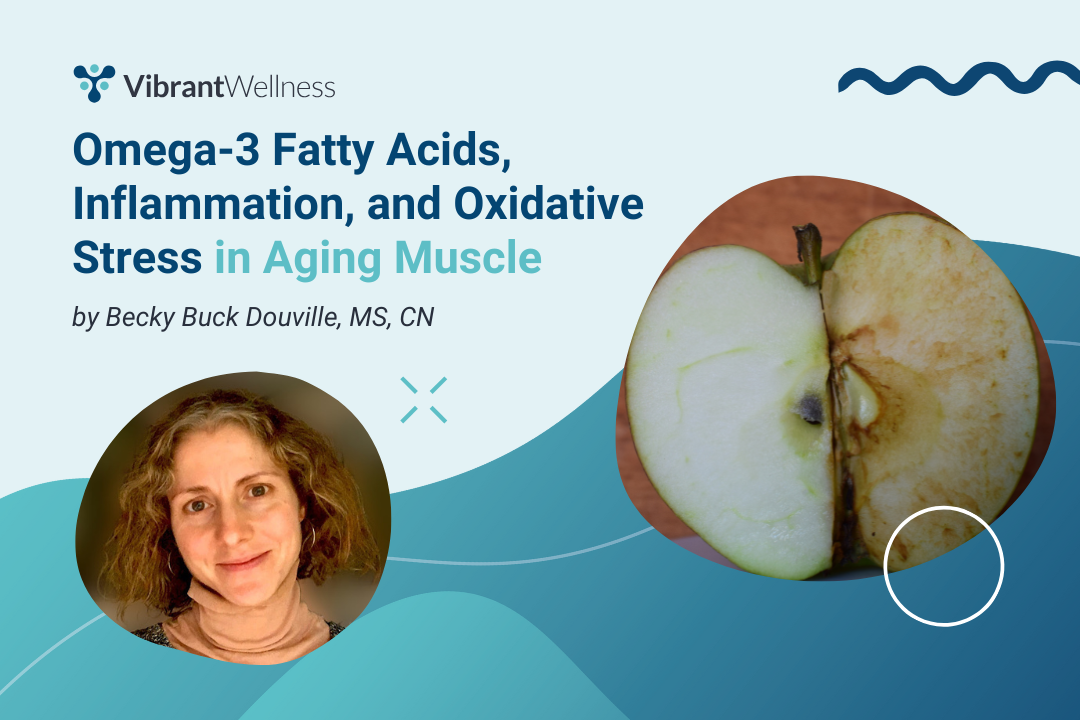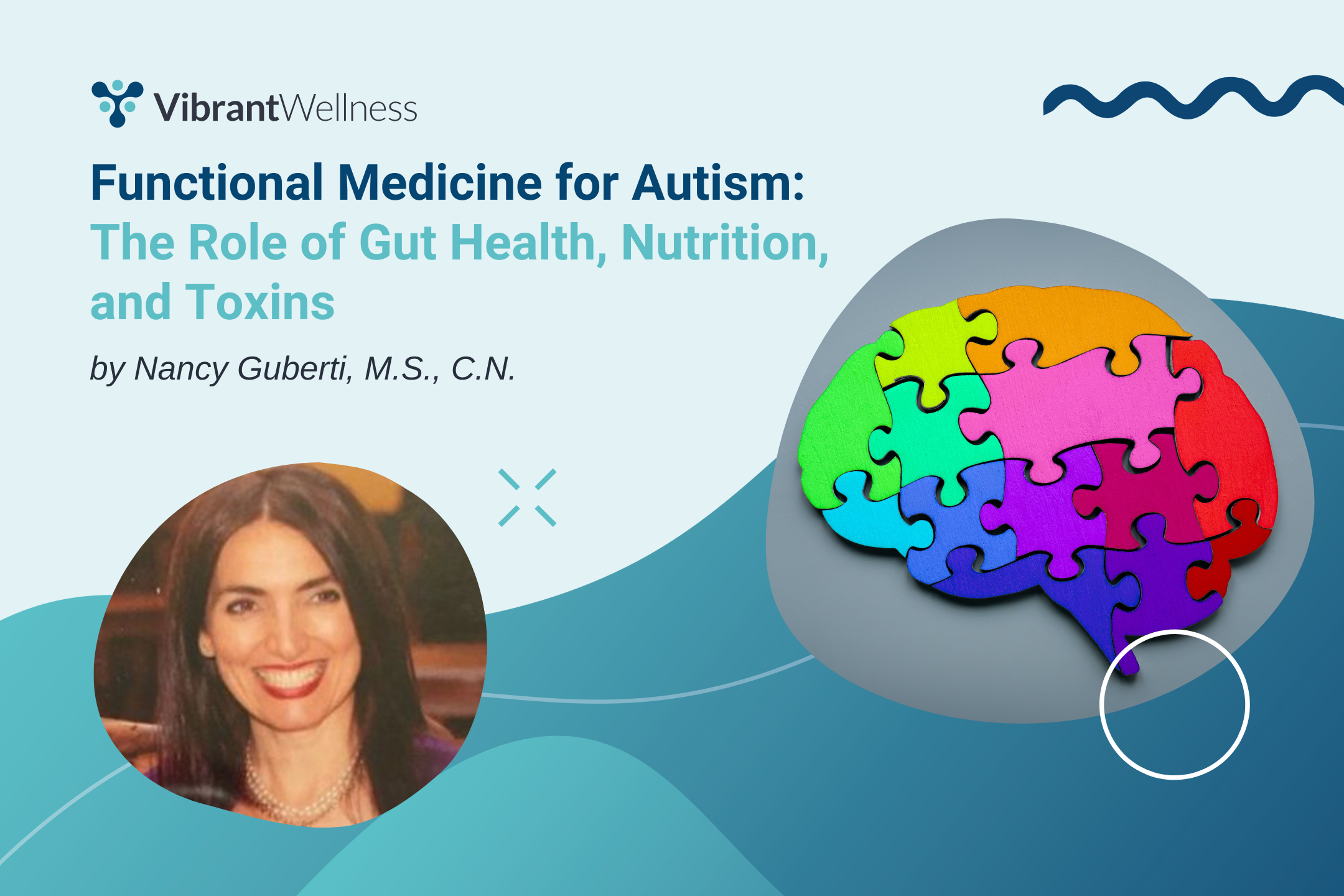Increasing VO₂ Max and Supporting Heart Health for Athletic Performance
Clinically reviewed by Dr. Mary Beth Augustine, DCN, RDN, FAND
Endurance athletes, such as runners, cyclists, rowers, and triathletes, often strive to push their VO₂ max higher. They want to use more oxygen during maximal exertion, leading to stronger performance.
Advanced integrative testing can help by revealing subtle metabolic and genetic factors influencing performance. This article will outline the core principles of VO₂ max, examine evidence-based ways to increase it, and discuss how innovative tests like the Vibrant Wellness CardiaX, Cardiac Health Panel, and Methylation Panel offer insights that standard bloodwork and physicals can miss.
Table of Contents
Understanding VO₂ Max and Its Importance

VO₂ max represents the maximal volume of oxygen the body can use per minute relative to body weight. It often tracks an athlete’s peak aerobic capacity. High VO₂ max numbers correlate with better endurance performance in distance running or cycling activities.
Multiple physiological systems contribute to VO₂ max:
- Heart and blood vessels
Stroke volume (amount of blood the heart pumps per beat), capillary density, and arterial compliance each affect oxygen delivery. - Lungs
Pulmonary function influences oxygen uptake and carbon dioxide clearance, though the lungs are rarely the limiting factor in healthy individuals. - Muscle and mitochondria
Muscle cells must extract oxygen from the blood and use it effectively during aerobic metabolism. More mitochondria and oxidative enzymes help generate ATP for muscle contraction.
Evidence-Based Methods to Increase VO₂ Max

Scientists have studied aerobic development for decades, and several clear strategies have emerged. Each hinges on delivering enough stimulus to adapt, paired with adequate recovery.
1. Interval Training
High-intensity interval training (HIIT) is known for elevating VO₂ max. Short bursts at or above the lactate threshold, followed by brief recovery, create a potent stimulus. A meta-analysis published in PLoS ONE found that intervals had a greater impact on aerobic capacity than continuous moderate exercise for many individuals.¹
- Example Workout
5 x 4-minute intervals at roughly 90–95% of maximum effort, each separated by 2 minutes of active recovery (easy jog or spin). Over time, an athlete might add more intervals or lengthen them slightly as tolerance improves.
2. Lactate Threshold Training
Training at the intensity where lactate accumulates can improve the body’s ability to clear it. Maintaining speed or power near that threshold—a pace one could hold for around 30–60 minutes—can raise VO₂ max indirectly by boosting efficiency.²
- Example Workout
A 20-minute tempo run or ride at a challenging but sustainable pace. Runners might keep their heart rate near 85–90% of max. Repeating once or twice per week can stimulate aerobic adaptation.
3. Long Steady Sessions
Long runs or rides develop aerobic capacity, capillary density, and metabolic flexibility.³ Many endurance athletes schedule one extended effort per week. Although intervals are often the big driver of VO₂ max gains, steady mileage supports the overall engine.
- Example Workout
A continuous run or ride at a comfortable pace—45 minutes to 3 hours, depending on experience. This nurtures base endurance, helps the body become more efficient at fat oxidation, and prepares for race demands.
4. Strength Training
Research supports supplementary strength work to improve running and cycling economy.³ Heavier compound lifts (squats or deadlifts) can enhance neuromuscular coordination, which might translate to improved VO₂ max when combined with interval-based routines.
5. Recovery and Sleep
Intense training breaks muscle fibers down, pushes the heart, and taxes the nervous system. Gains happen when the body has time and resources to rebuild. Aim for seven to nine hours of sleep most nights, as recommended by the National Sleep Foundation.⁵ Sleep deprivation can limit VO₂ max improvement. Interval sessions that exceed recovery capacity may lead to elevated cortisol, immune strain, and overuse injuries.
Overtraining and Cardiac Load

Pushing intensity and volume too far can lead to overtraining syndrome—a state where the body struggles to recover, hormone levels falter, and performance declines. Some endurance athletes maintain high weekly training volumes or frequent high-intensity sessions without planned deload weeks.⁶
Indications of overtraining include:
- Mood dips or irritability
- Elevated resting heart rate
- Frequent colds or minor illnesses
- Poor sleep and lack of motivation
- Performance plateaus or regressions
One study in the International Journal of Sports Physiology and Performance highlights how incomplete recovery can weaken long-term adaptation.⁷ If a runner performs tough interval sessions on legs that never fully recovered, the body might respond by raising cortisol, which degrades muscle and hampers VO₂ max improvements.
Checking advanced markers through the Cardiac Health or the Methylation panel may reveal high homocysteine or raised inflammatory markers, indicating that training volume may be beyond recovery capacity.
Recovery Modalities
In addition to adjusting training volume, many athletes find value in:
- Massage: Can reduce muscle tension and promote circulation.
- Foam Rolling: Helps release myofascial tightness and may support flexibility.
- Contrast Therapy (Hot/Cold): Can stimulate blood flow and reduce perceived soreness.
- Deload: Short-term deload weeks, combined with these modalities, can give the body the extra rest needed to handle intervals more effectively in the long run.
Hidden Limits on VO2 Max

Many athletes focus on specific training methods to increase VO₂ max—interval workouts, threshold training, tempo sessions, and volume progression.
Yet, Research from exercise physiology guidelines suggests that unaddressed issues such as poor recovery or unrecognized inflammatory markers might also cap improvements.¹ More advanced heart health testing can help identify these potential weak links.
Integrative Testing for Athletes
Many athletes focus on increasing VO₂ max through structured workouts yet neglect underlying factors such as genetic variations, inflammatory markers, or nutrient imbalances.
Tests like CardiaX, Cardiac Health Panel, and Methylation Panel can reveal potential metabolic or genetic patterns that can influence endurance gains and cardiac resilience.
Additionally, nutrient-focused tests such as the Micronutrient Panel, Whole Blood Nutrient Profile, and NutriPro provide insights into vitamin, mineral, and antioxidant levels that may impact recovery, inflammation, and muscle function.
CardiaX: Genetic Insights for Heart Health and Performance
The Vibrant Wellness CardiaX panel interprets 21 genetic variants tied to cardiovascular function. These genes affect lipid handling, blood pressure regulation, and more. The test provides valuable data about genetic patterns that could shape training choices.
- Notable markers include:

- CYP1A2: Impacts caffeine metabolism. Individuals who slowly break down caffeine might experience higher blood pressure for longer after consuming coffee or energy drinks, as shown in a recent study published in JAMA.⁸
- NOS3: Influences nitric oxide production—connected to vascular dilation. Inadequate nitric oxide can limit oxygen delivery to muscles.
- MTHFR: Regulates homocysteine metabolism. Variants can set the stage for mild homocysteine elevations if B vitamins are lacking, potentially affecting the blood vessel lining.
For example, a runner with a slow-metabolizer CYP1A2 variant might experience palpitations or insomnia after afternoon caffiene. Reducing caffeine or consuming it earlier could yield better sleep and a steadier heart rate, indirectly boosting training output and VO₂ max gains.
View the CardiaX key clinical messages here.
Cardiac Health Panel: Advanced Lipids and Inflammatory Markers
The Cardiac Health Panel provides more depth than a standard cholesterol test. It examines:
1. Lipoprotein Subfractions- sdLDL (small, dense LDL): Associated with a higher propensity to infiltrate arterial walls.
- Lp(a): A form of lipoprotein that can contribute to plaque buildup.

- Apo A-1: Often linked with “good” HDL function.
- Apo B: Reflects the number of atherogenic particles.
- PLAC (Lp-PLA2): Can correlate with plaque vulnerability.
- MPO (Myeloperoxidase): Ties to white blood cell activity and oxidative stress.
- ox-LDL: Oxidized LDL can provoke an inflammatory response.
- hs-CRP: High-sensitivity C-reactive protein used in multiple studies to gauge systemic inflammation.
- Homocysteine: Elevated levels can irritate blood vessels.
- NT-proBNP: Reflects cardiac muscle stress.
An endurance athlete with healthy-looking standard cholesterol could still have an unexpected elevation in sdLDL or Lp(a).³ If paired with high hs-CRP or MPO, that might signal a need to refine diet, rest, or training structure. These markers can point out possible stressors that might also affect adaptation capacity for VO₂ max training.
For example, a cyclist with normal LDL but a high Apo B: Apo A-1 ratio and elevated MPO may benefit from increased omega-3 fats and antioxidants. If the athlete also feels under-recovered, adjusting training volume or adding a rest day might reduce inflammation and improve readiness for high-intensity sessions.
Read the Cardiac Health Panel key clinical messages here.
Methylation Testing: Impact on Recovery and Oxygen Delivery
The Methylation Panel measures functional levels of folate, vitamin B12, and homocysteine while checking specific genetic single-nucleotide polymorphisms (SNPs) for MTHFR, COMT, NOS3, and more. Methylation imbalances could subtly affect endurance adaptation or oxygen delivery:
- Excess Homocysteine

Excess homocysteine can irritate the vascular endothelium. While mild elevations might not cause symptoms, they can correlate with reduced arterial flexibility. That matters when oxygen-rich blood must reach working muscles.
- B Vitamin Status
Vitamin B12 and folate help maintain normal methylation cycles. Low levels can interfere with red blood cell production and hamper tissue oxygenation under stress.
- COMT
COMT affects how catecholamines—like adrenaline—are broken down. If they linger too long, blood pressure and heart rate might remain elevated, influencing recovery.
For example, if methylation testing reveals that a triathlete with borderline-high homocysteine has a variant in MTHFR, their provider might recommend a diet with more leafy greens and targeted supplementation. Over time, reduced homocysteine may correlate with smoother recovery from interval sessions.
Read the Methylation Panel key clinical messages here.
Linking VO₂ Max Improvements with Lab Findings
1. Aerobic Adaptation and Nutrient Deficiencies
If repeated threshold or interval sessions are not boosting VO₂ max, iron, B12, or folate status may be to blame. Anemia reduces the blood’s ability to carry oxygen—dampening efforts to raise VO₂ max. Although the Methylation Panel is not an anemia test, combining it with nutrient-focused tests like the Micronutrient, Whole Blood Nutrient Profile, and NutriPro panels can provide a clearer picture of key vitamin and mineral levels. These tests assess essential nutrients such as iron, B12, folate, and other cofactors needed for red blood cell production and oxygen transport. Addressing any deficiencies uncovered by these panels may support aerobic adaptation and overall endurance.
Learn about the role of omega-3 fatty acids, inflammation, and oxidative stress in aging muscle here.
2. Hidden Inflammation and Training Regression
Even well-structured plans can stall if chronic inflammation escalates. That can happen if an athlete trains too intensely while ignoring rest. If the Cardiac Health Panel indicates elevated hs-CRP or MPO, a short-term deload week might help. On the next training cycle, the body might handle intervals better and thus see a bump in VO₂ max.
3. Genetic Factors and Caffeine Use
Some athletes rely on caffeine to sustain efforts or sharpen focus. If CardiaX testing suggests slow caffeine metabolism, repeated spikes in blood pressure may become counterproductive. Cutting back on pre-workout stimulants could reduce stress on the cardiovascular system, supporting consistent VO₂ max improvements.
Practical Training Tips for VO₂ Max Gains

- Structure Workouts Across Mesocycles
Rather than random intervals, plan 3–4 weeks of progressive overload with intervals, tempo work, and a long session each week. Then, include an easier week to allow full recovery. - Watch Intensities
Many rely on heart rate, pace, or power targets. Intervals for VO₂ max often hover between 90–100% of maximum effort. Pacing them well, with adequate rest, encourages maximum oxygen uptake. - Combine Strength and Endurance
Plyometric exercises—such as box jumps or bounding—may refine running economy, indirectly aiding oxygen utilization. Strength exercises like squats and lunges help the lower body produce force with less metabolic strain. Learn about the interplay between strength training, managing oxidative stress, and muscle growth here. - Optimize Sleep
Consistent seven to nine hours of sleep can boost testosterone, growth hormone, and overall recovery. Missing sleep repeatedly increases inflammatory markers, which may lower training quality. - Manage Stress
Job, family, or life stress can exacerbate overtraining. Techniques like breathing exercises or short mindfulness sessions can support mental resilience, possibly lowering persistent inflammatory signals. A stable mental state often translates to better workout execution.
Outdoor Activity, Mental Well-Being, and Heart Health
Moving outdoors can benefit those seeking a VO₂ max bump. Trail running or cycling on scenic roads may enhance mental calmness and reduce perceived stress. A paper in Frontiers in Psychology suggested that exposure to natural environments helps people feel less anxious and more focused.⁵ This advantage might be subtle, but mental relief can allow the body to recover more effectively. When an athlete’s mind is calmer, interval and threshold workouts might be more productive. Stress hormones that drive inflammation also stay in check.

Key Points About VO₂ Max and Advanced Testing
- VO₂ Max is Multifactorial: Many physiological elements—heart function, muscle oxidative capacity, oxygen transport—converge to influence it.
- Training Must Include High-Intensity Sessions: Intervals spur significant gains when paired with proper recovery.
- Genetic Factors and Metabolic Patterns Matter: Certain genetic variants or suboptimal nutrient levels can impact adaptation.
- Inflammation Can Stall Gains: Overreaching drives up markers that hamper performance. Testing for CRP, MPO, and ox-LDL can reveal underlying strain.
Addressing these factors in tandem supports a more efficient, data-driven path to a higher VO₂ max and greater success in endurance goals.
Putting It All Together

Pursuing a higher VO₂ max is a complex undertaking. Interval training, threshold work, and progressive volume are well-established methods. Sleep, strength work, and stress management also play major roles. Meanwhile, hidden factors can limit adaptation. Genetic variants such as slow caffeine metabolism or MTHFR mutations may influence how the body responds to training, fueling, and rest. Lipid subfractions such as sdLDL or Lp(a) and inflammatory markers can remain undetected in regular checkups.
Functional testing like the Vibrant Wellness CardiaX test, Cardiac Health Panel, and Methylation Panel can clarify these blind spots, revealing areas to monitor and guiding nutrition and training adjustments.
A thorough approach to V02 max improvement integrates advanced training principles, personalized nutrition, and a clear sense of individual physiology. That integrative approach can help endurance athletes adapt, recover, and reach higher performance levels with a stronger understanding of their cardiovascular well-being.
About the Author
Tyana Smith combines her passion for health optimization with her love of words and marketing as the Senior Content and Brand Marketing Manager at Vibrant Wellness. She hopes her writing will arm wellness professionals with the knowledge and insights they need to transform patient outcomes and make personalized, root-cause healthcare more accessible to all. Tyana is infinitely curious and stays at the forefront of longevity trends and scientific research to better serve her audience—and, selfishly, herself. She's a proud graduate of Johns Hopkins University's Zanvyl Krieger School of Arts and Sciences, where she received a master’s degree in communication, with an emphasis on unpacking complex topics to make them accessible and engaging.
References:
- American College of Sports Medicine (ACSM). ACSM's Guidelines for Exercise Testing and Prescription, 10th ed. Lippincott Williams & Wilkins; 2018.
- Bacon AP, Carter RE, Ogle EA, Joyner MJ. VO₂max trainability and high intensity interval training in humans: a meta-analysis. PLoS ONE. 2013;8(9):e73182.
- Midgley AW, McNaughton LR, Wilkinson M. Is there an optimal training intensity for enhancing the maximal oxygen uptake of distance runners? Empirical research findings, current opinions, physiological rationale and practical recommendations. Sports Med. 2006;36(2):117-132.
- Sairam SG, Sola S, Barooah A, et al. The role of Lp-PLA2 and biochemistry parameters as potential biomarkers of coronary artery disease in Asian South-Indians: a case-control study. Cardiovasc Diagn Ther. 2017;7(6):589-597. doi:10.21037/cdt.2017.08.13
- National Sleep Foundation. How Much Sleep Do We Really Need? Accessed 2023. https://www.thensf.org/how-much-sleep-do-we-really-need/
- Halson SL. Overtraining in elite sports: a practical overview. Sports Health. 2014;6(2):95-7. doi:10.1177/1941738113520306
- Kellmann M, Bertollo M, Bosquet L, et al. Recovery and performance in sport: consensus statement. Int J Sports Physiol Perform. 2018;13(2):240-245.
- Cornelis MC, El-Sohemy A, Kabagambe EK, Campos H. Coffee, CYP1A2 genotype, and risk of myocardial infarction. JAMA. 2006;295(10):1135-1141. doi:10.1001/jama.295.10.1135
- Kuo M. How might contact with nature promote human health? Proposing mechanisms and a research framework. Front Psychol. 2015;6:1093. doi:10.3389/fpsyg.2015.01093
Regulatory Statement:
The information presented in case studies have been de-identified in accordance with the HIPAA Privacy protection.
The general wellness test intended uses relate to sustaining or offering general improvement to functions associated with a general state of health while making reference to diseases or conditions. This test has been laboratory developed and its performance characteristics determined by Vibrant America LLC and Vibrant Genomics, a CLIA-certified and CAP-accredited laboratory performing the test. The lab tests referenced have not been cleared or approved by the U.S. Food and Drug Administration (FDA). Although FDA does not currently clear or approve laboratory-developed tests in the U.S., certification of the laboratory is required under CLIA to ensure the quality and validity of the test.
 By
By





